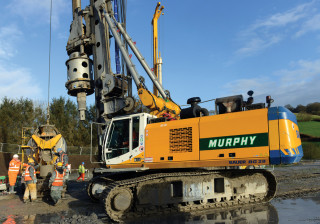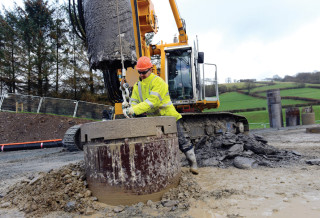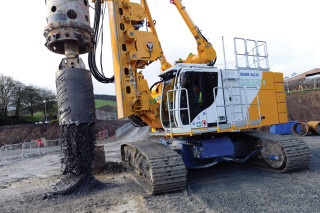The first section of piling works on an aqueduct that is more than a century old has just been completed by construction and engineering firm J Murphy & Sons. It is one of the first steps in a multi-million-pound project to upgrade and modernise the Elan Valley Aqueduct (EVA) in mid-Wales and safeguard what is currently Birmingham’s only source of clean water.
Murphy was working with main contractor, BNM Alliance, a joint venture between Barhale and North MidlandConstruction/NMC Nomenca. BNM Alliance won the contract to replace three sections of the aqueduct, at Bleddfa, Knighton and Nantmel, where water will be diverted through newly built tunnels and the old conduit will be shut down completely.
The JV was formed to share the risk and the workload of what is a very large project. In each case a bypass tunnel is being constructed alongside the existing aqueduct so that water will be diverted from the older aqueduct into the new pipeline on completion. The redundant section of aqueduct will then be drained and sealed – mothballed in effect – so that, if necessary, it could be brought back into use and incorporated into a larger network should Birmingham’s water requirements demand it in the future.
Bleddfa is the first pipe bypass to be constructed, and Murphy is putting in large- diameter concrete secant piles to provide ground support for the drive and reception pits from which the new tunnels will be constructed.
These pits will accommodate the new tunnelling equipment that the joint venture has ordered for the project - a new Earth Pressure Balance tunnel boring machine (TBM) supplied by German manufacturer Herrenknecht to deal with rock strengths up to 190MPa and 10bar of external water pressure.
The drive pit at Bleddfa is the deeper of the two pits at 12m deep, and has to enclose the existing aqueduct to enable flow diversion works on completion. Continuous-flight auger (CFA) piling – the least intrusive piling method – was specified and during piling operations vibration levels in the aqueduct were monitored through an array of sensors that were installed in the existing structure during an earlier two-day shutdown. These sensors trigger an alarm if the maximum reading of 15m/sec is exceeded.
Christopher Fox, project manager with Murphy International for the EVA piling project says that the client, Severn Trent Water, and its designer GHD Livigunn, provided the specification, the site investigation and the basic pile layout for the cofferdam for the TBM launch shaft.
But this left Murphy and its geotechnical consultant, Byrne Looby, to develop their own solution to the project’s constraints.
The principal challenge was that the piled cofferdam was to extend over the existing EVA but there was no complete certainty as to its exact location – it did not have an accurately defined depth, though it was known to be about 8m beneath the surface.
In the original design the piles stopped some 2m above where the aqueduct was thought to be but that would have left a gap between the bottom of the piles and the top of the existing EVA. This would have meant that the soil would be unsupported for the shaft dig and would have collapsed into the reception shaft.
The solution was to drive the two outer sheet piles 10.5m deep, up to half their width in to fresh concrete in the last female pile. This was done using Murphy’s own Movax hammer and ensured a continuous retaining wall could be maintained. The intermediate sheet piles were driven to a depth of 6m so they were approximately 2m above the existing aqueduct. The complete piling structure consists of a combination of 1,200mm-diameter secant piles and sheet pile wall.

“This construction system would not be very commonly used, but this unique solution ensured the integrity of the live EVA,” says Fox. “The advantage with this design is that while the launch pit for the TBM is being excavated, the intermediate sheet piles can be driven down as they go until they reach the top of the existing aqueduct – and there will be no danger of the existing ground collapsing.”
The shaft consists of 120 piles, each 1,200mm in diameter, that were bored up to 15m deep into rock sockets of up to 7m deep, and 24 steel sheet piles that were to be installed in two areas over the existing sections of the aqueduct.

In order to meet the client’s requirements, Murphy bought a brand new Bauer BG26 rig. This was delivered straight to site and together with Murphy’s existing Bauer BG28 completed the secant piles. The reception shaft is due to start in May using a similar pile layout and construction.
“The major constraints for the project were not limited to preventing any impact on the existing aqueduct,” said Geoff Hancock, customer liaison manager for North Midland Construction/NMCNomenca.

“The challenge is also to carry out a major civil engineering project in a rural setting with limited infrastructure. In this case Murphy has to bring its big rigs and materials to site. Their work acts as a bridgehead for the project in terms of impact on the local community, so it is important to set the right tone.
“The tunnelling works will carry on for six to eight months after piling operations, and in the case of the drive shaft, will be close to the centre of a village of 50 dwellings so it is important that the work has been carried out in a professional manner. The reception shaft is 1.8km away in a more remote area where there are only three or four farms in the vicinity.”
The whole Birmingham Resilience Project is under pressure for an early completion, due to a self-imposed target. When it won Ofwat approval for the scheme, Severn Trent committed to completion by 2020, but its internal target is a special date in 2019, as Severn Trent project manager Simon Hinsley explains:
“We’re currently working on the basis of a three-year construction and commissioning period, and our plan is to have the physical infrastructure finished for our chief executive to come and cut the ribbon on the 21st July 2019. That’s 115 years to the day since King Edward VII opened the Elan Valley Aqueduct. I’m keenly aware of the historical legacy of the aqueduct and so I thought it was a great date to go for.”

Birmingham Resilience Project
The piling project at Bleddfa is one of the first elements of the Birmingham Resilience Project (BRP) that will allow Severn Trent Water to safeguard the EVA and secure another century of service. But, curiously, the roots of the BRP are some miles away – Tewkesbury.
Nearly nine years ago, in July 2007, severe flooding incapacitated Severn Trent Water’s treatment works at Mythe, Tewkesbury, leaving around 350,000 people without a supply of mains water for two weeks. Because the town is at the edge of Severn Trent’s distribution network it did not have many alternatives for a piped supply. The result was a civil emergency requiring tankers and the distribution of bottled drinking water.
The incident prompted an industry-wide review of operational resilience. Although the EVA is drained annually for maintenance inspections, Severn Trent Water carried out a full structural investigation of the entire length of the aqueduct and the subsequent Birmingham Resilience Study to assess potential failure modes, consequences and supply upgrade options.
The BRP, a £242m infrastructure programme - the biggest in Severn Trent’s history - is the result.
The project will deliver a new water supply from Lickhill, near Stourport-on-Severn, into Birmingham to allow extended planned maintenance shutdowns of the EVA (as well as providing a back-up for any emergency events) and strengthen its treatment processes at Frankley water treatment works.
The new supply will be used every other year, for up to 50 days during the winter months, to allow planned maintenance on the aqueduct. In this way, the aqueduct can receive an ongoing programme of more extensive refurbishment and protection and safeguard its operational life.
During shut-down periods, Birmingham will continue to receive water from the new River Severn source, as well as other sources local to the city and from Severn Trent’s strategic grid network.
The pipeline that’s a life-line
The Elan Valley Aqueduct (EVA) is one of the great Victorian achievements of civil engineering. Before its construction, water-borne diseases such as cholera and typhoid were commonplace in Birmingham and concern for public health led Sir Joseph Chamberlain MP and Birmingham City Council to seek a source of clean, healthy water.
That source was Elan Valley, 73 miles away in Powys. Over the course of 12 years from 1892 to 1904, a 50,000-strong workforce constructed the EVA, producing a waterway that transports water by gravity alone – with no pumped assistance at any point – at one mile an hour in a journey of just over three days from the Welsh valley to the West Midlands.
The aqueduct improved the quality of life for the people of Birmingham enormously and has probably saved thousands of lives during its history. The celebrated sewerage system created by Sir Joseph Bazalgette performed a similarly important role for London.
When the EVA was opened in 1904, by King Edward VII and Queen Alexandra, around 16 million litres of water travelled through the pipe each day to supply a population of 630,000. Now 320 million litres flows to the 1.1 million people who live there today.
Got a story? Email news@theconstructionindex.co.uk


